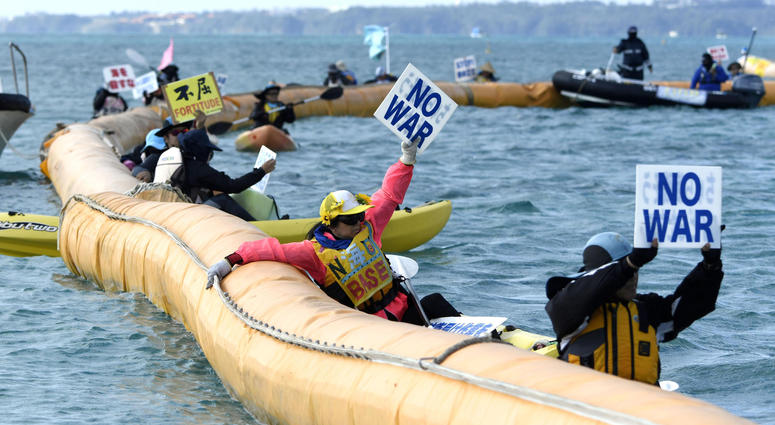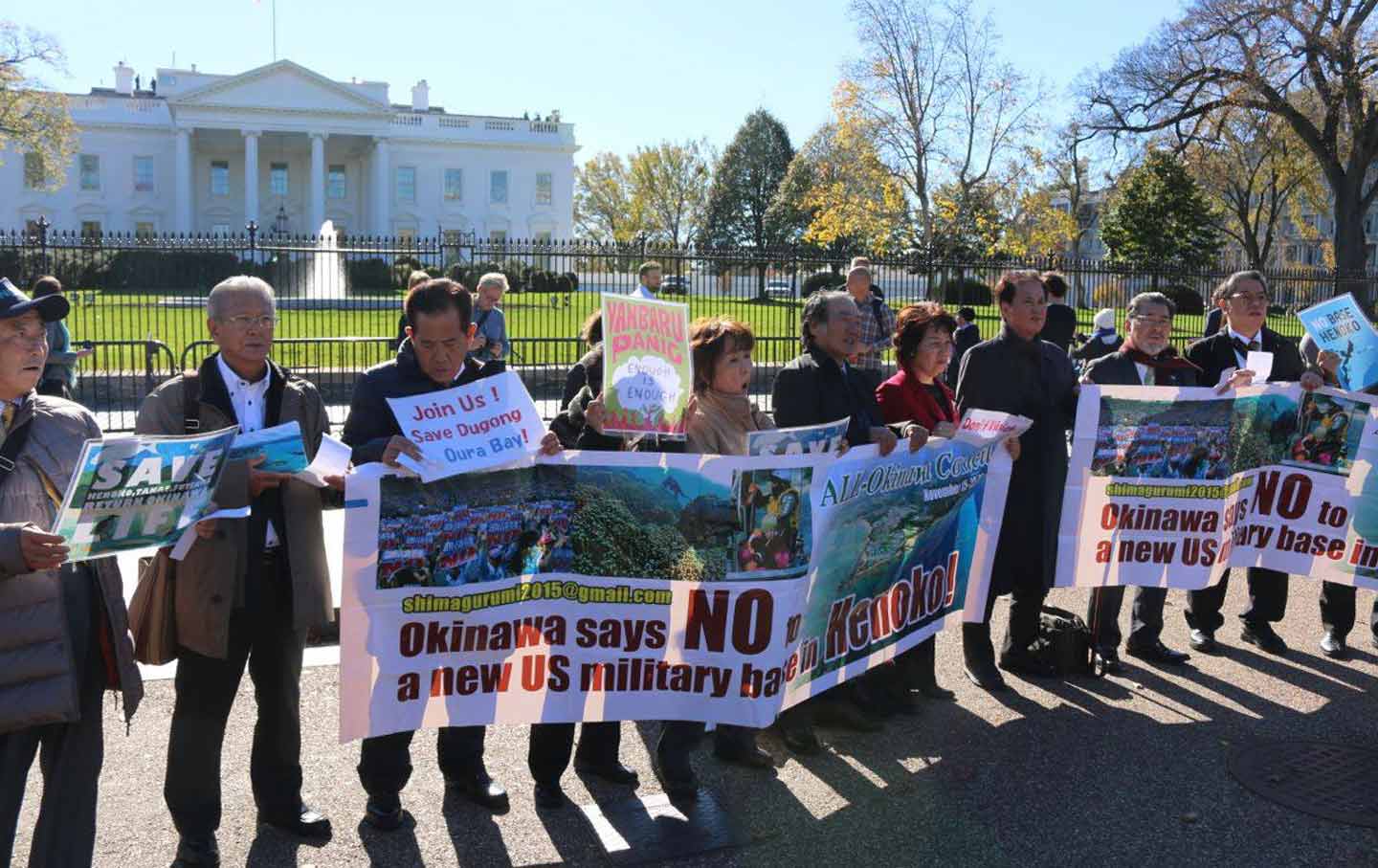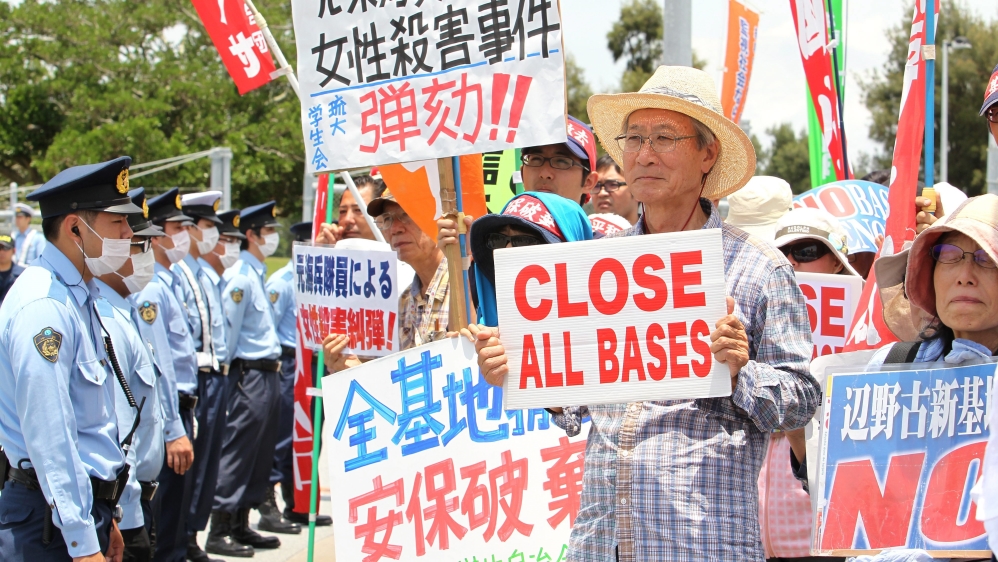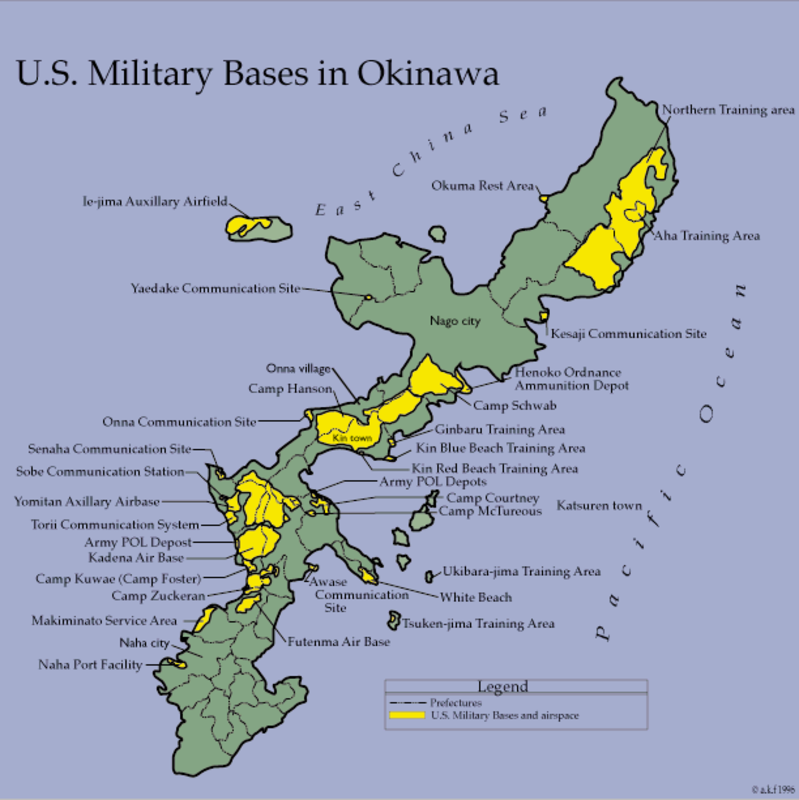
By Valerie Cha
In an attempt to reduce military activity and please the locals of Okinawa, the American and Japanese government developed a relocation plan. The project relocates Futenma Air base from a heavily populated area to a smaller region known as Henoko Bay. Although the plan was designed as a solution to Okinawa’s complaints on noise pollution and crimes, it expanded the controversial issue of the large American presence and the harm they bring to the island.
In reference to my previous blog, there is both a high volume of supporters and protesters of the project. Okinawans argue that relocating the base from Futenma to Henoko, based on the volume of the population, does not make logical sense. They believed that Americans are the root to the rising problems and they would only carry their dangerous habits to a new region. Another reason why Okinawans oppose the plan is that Henoko Bay is home to many marine wildlife. The project instructs construction workers to fill in the bay to create more land for the development. Marine wildlife plays a significant role in the island’s lifestyle, so destroying it causes great dispute.
Despite the residences’ opinion on the issue, the American and Japanese government argue to move forward with the plan in belief that the new location holds strategic value. They believe it would reduce American presence as it gives opportunity for American troops and their dependents to move off the island and allow more economic possibilities for locals in Henoko.
Moving forward, I will address how Okinawan millennial, who are beginning to understand the American-Japanese alliance, feel about the relocation project. I will also discuss the current political positions on the issue and the alternative plans that continue to place a hold on the project.
Charles Morrison, The Japan Times contributing author, conducted a research that centered the attitudes of 20 to 45-year-old Okinawans on the issue of American presence on the island. Morrison and his colleague administered dozens of interviews and online surveys to about 200 “millennial plus” Okinawans. He states, “It showed a broad consensus around the beliefs that Okinawa hosts more than its fair share of foreign military bases and that Tokyo does not give due regard to Okinawan views.” The study illustrated a wide support for increased access to the bases, better relations between American-service personnel and local communities, and “more dialogue on Okinawa base-related issues.” In general, Okinawans just want to be heard. They have been fighting and enduring the consequences of the U.S.-Japanese alliance for years. What the locals yearn for is not at all an extreme gesture by the U.S. and Japanese governments, but more of simple rights as hosts to the American-Japanese alliance.
In addition, Jiji Kyodo, another author to The Japan Times, states that the central government believes the relocation plan is the “only solution” to stopping the dangers that occurred at Futenma without interrupting the U.S.-Japan alliance. However, Morrison’s study found that a majority of the participants expressed disagreement to the idea that Henoko should be accepted as a means to close Futenma. The participants argue that “with tourism booming, the bases may no longer be as economically critical to Okinawa as they once were.” A government official who took part of the surveys and interviews says that Okinawans are not denying the great contributions of American bases but expressing their attitudes toward the large amount. He states, “It’s just that we have too many of them.”
Concluding the survey were thoughts on possible improvements for the relocation plan and its rising issues. The study suggests that “the current mode of defensively reacting to problems rather than proactively seeking to lessen impacts can be changed.” The participants argued that Okinawan voices on the issues that are affecting them should be heard and be as valuable as any other U.S.-allied country. The study suggests that Tokyo should acknowledge and be sensitive to Okinawan feelings and make efforts to honor the Okinawan culture. So how can the two governments create an appropriate channel for Okinawan voices to be heard?
According to Daniel Hurst, The Diplomat‘s freelance journalist based in Tokyo, Okinawa Governor Denny Tamaki called for a meeting with the Japanese central government and the United States earlier this year in March. During the meeting Tamaki proposed an idea that would allow the Okinawa government to have more control over their island through the Special Action Committee on Okinawa (SACO). SACO is a process that was established in 1995 by the U.S. and Japanese governments to develop plans of base realignment and reduce the burden that the bases have on the island (Hurst, 2019). Tamaki insisted that the Okinawan prefectural government be involved in a relaunched SACO because it is now time for Tokyo and Washington to set up a “SACO plus Okinawa” dialogue “to verify the progress regarding the SACO agreement as well as to study the return of the base” (Hurst, 2019).
Furthermore, the meeting resulted in the success of the governments’ commitment to continue dialogue with the Okinawan locals but a failure to postpone the project. During a press conference that followed the meeting, Japanese Defense Minister Takeshi Iwaya stated that Tokyo would continue to explain its stance “carefully and persistently to the people of Okinawa” and hoped to be able to “gain their understanding.”
It seems as though the issue at hand stand is still as controversial as it was decades ago with all governments refusing to give in to the other. Based on my research for opposing and supporting perspectives, I can suggest that there is no middle line that exists between the issue. Okinawans are fighting to close the base completely, meanwhile the American and Japanese governments are fighting to relocate the base instead. In my opinion, if the U.S. and Japanese governments are willing to relocate the base to a smaller location and reduce the amount of military personnel and their dependence by sending them to surrounding countries, doesn’t that mean Okinawa and the U.S.-Japanese alliance can afford to reduce the American presence on the island altogether? As stated above, tourism in Okinawa is a great contribution to the economy and the number of bases on the island, if Futenma was to close off completely without the relocation, would still be high with a large American presence remaining.
I believe that the people of Okinawa and their government understand that they play a small authoritative role in the decision making of their home. It appears that their demand for change may be impossible against the two larger governments, but Okinawans are resilient and pushing for a greater voice to take back their island. Since the Battle of Okinawa during WWII, locals have been fighting for one thing: for their voices to be heard. It is known that Okinawa has long suffered the U.S.-Japan alliance for decades. But I believe it’s time we highlight the perspectives and cries of Okinawa protestors. As Jinshiro Motoyama, an Okinawa activist, says, “The central government should not trample on the Okinawan people’s will. We hope democracy is still alive in this country” (Hurst, 2019).









/arc-anglerfish-arc2-prod-mco.s3.amazonaws.com/public/RNKEWY2MANAQLPLLVLRQU2LTKE.jpg)


